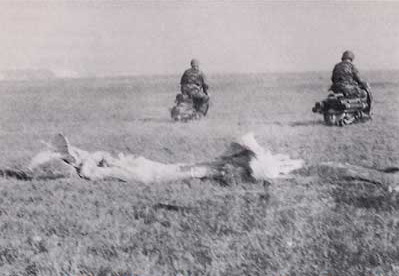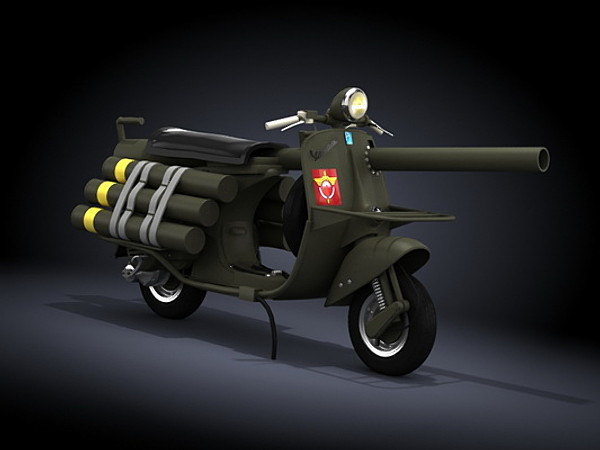
|
|
|
|
|
|
Classic Bikes
Custom Bikes
Individual
Racing Bikes AJP
AJS
Aprilia
Ariel
Avinton / Wakan
Bajaj
Benelli
Beta
Bimota
BMW
Brough Superior
BRP Cam-Am
BSA
Buell / EBR
Bultaco
Cagiva
Campagna
CCM
CF Moto
Combat Motors
Derbi
Deus
Ducati
Excelsior
GASGAS
Ghezzi Brian
Gilera
GIMA
Harley Davidson
Hero
Highland
Honda
Horex
Husaberg
Husqvarna
Hyosung
Indian
Jawa
Kawasaki
KTM
KYMCO
Laverda
Lazareth
Magni
Maico
Mash
Matchless
Mondial
Moto Guzzi
Moto Morini
MV Agusta
MZ / MuZ
NCR
Norton
NSU
Paton
Peugeot
Piaggio
Revival Cycles
Roland Sands
Royal Enfield
Sachs
Sherco
Sunbeam
Suzuki
SWM
SYM
Triumph
TVS
Ural
Velocette
Vespa
Victory
Vincent
VOR
Voxan
Vyrus
Walt Siegl
Walz
Wrenchmonkees
Wunderlich
XTR / Radical
Yamaha
Zero
Video
Technical
Complete Manufacturer List
|
Vespa 150 TAP

The Vespa 150 TAP is a Vespa scooter modified for
use with paratroops (Troupes Aéro Portées, or TAP). Introduced in 1956 and
updated in 1959, it was produced by Ateliers de Construction de Motocycles
et Automobiles (ACMA), the licensed assembler of Vespas in France at the
time.
Modifications from the civilian Vespa included a reinforced frame and a
three inch recoilless rifle mounted to the scooter.
The 150 TAP's mounted M20 75 mm recoilless rifle, a
U.S.-made light anti-armour cannon, was very light in comparison to a
standard 75 mm cannon but was still able to penetrate 100 mm of armour by
HEAT warhead. The recoil is counteracted by venting propellant gases out the
rear of the weapon which eliminated the need for a mechanical recoil system
or heavy mounts, enabling the weapon to be fired from the Vespa frame.
The scooters would be parachute-dropped in pairs,
accompanied by a two-man team. The gun was carried on one scooter, while the
ammunition was loaded on the other. Due to the lack of any kind of aiming
devices the recoilless rifle was never designed to be fired from the
scooter, the gun was mounted on a tripod which was also carried by the
scooter, before being fired.
Vespa's factory-developed Vespa Force Armate prototype
was envisaged with a variety of options, including mounting a submachine-gun
on the handlebars, a radio under the saddle and an armored leg shield.
Though NATO trials showed the Vespa Force Armate was only
3 mph (5 km/h) down on the much larger traditional military bikes of the
time in terms of top speed, and resulted in glowing appraisals. But after
more than two years of negotiations, Enrico Piaggio canned the model. In a
letter sent by Piaggio himself in 1952, he concluded he was “not interested
in canvassing for State Orders since we know that its organs pay low prices
and late” and that he was convinced that “the military are not worth the
time of day.”
Hence when the French military decided it wanted a better
mobility option for its airborne special forces ("Troupes Aéro Portées",
hence the subsequent “TAP” acronym) than its existing American-made WWII
Cushman scooters for the Algerian War, it organized a competition between
French manufacturers for a replacement model.
In the end, it boiled down to a three-way shoot-out
between prototypes based on the Valmobile 100, the Bernardet 250 and the
Vespa. French Vespa licensee ACMA won the gig.
Despite an unmistakably different profile, the Vespa 150
TAP differed little from the Vespa scooter of the time. It used a 150cc
two-stroke engine derived by ACMA from the Vespa 125 motor, with different
bore and stroke to the Vespa 150 engine from the factory.
Other than the engine, plus the M20 light anti-armor
cannon, rack and ammunition mounts, the only major differences to a standard
Vespa were a strengthened frame and lower gearing which gave it a top speed
of just 40 mph (64 km/h).

|
|
|
Any corrections or more information on these motorcycles will be kindly appreciated. |